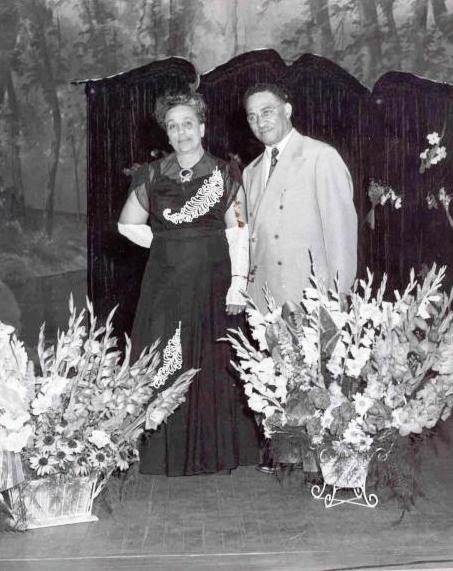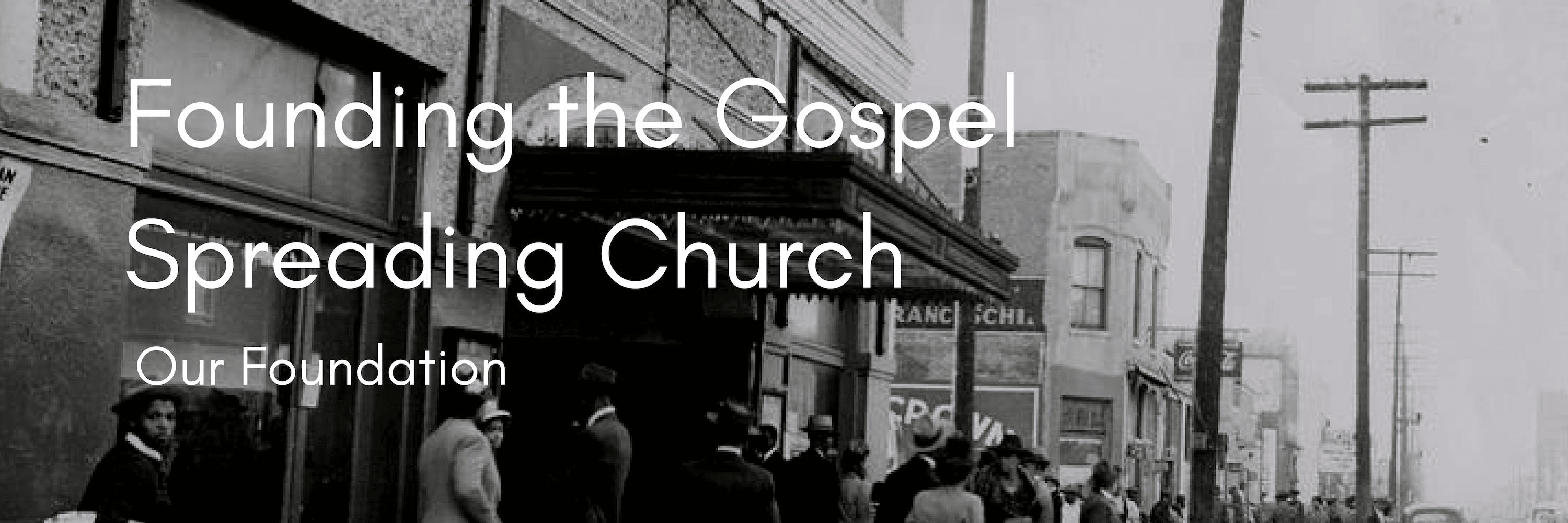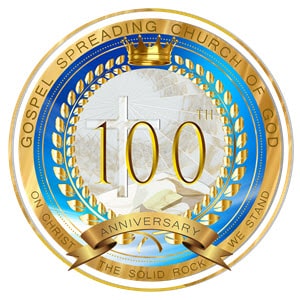

Elder Lightfoot Solomon Michaux was born on November 7, 1884, to John and May Blanche Michaux in Newport News, Virginia. Young Lightfoot attended John Marshall Elementary School, where his formal education probably ended at an early age; however, he remained a life-long student who continued to study both independently and, later with the aid of private tutors.
The Michaux family was in the seafood business and young Lightfoot became an astute business person, who operated his own business at an early age. He also operated a dance school where he met his future wife, Mary Eliza Pauline, whom he married around 1906. By 1911, the couple had built their own beachfront home on Pinkett’s (aka Pinky’s) Beach, on Ivy Avenue in Newport News. By 1917, Lightfoot had become a prosperous businessman, working in Tidewater, Virginia, and securing large government contracts. As a result of one of these contracts, he worked in Hopewell, Virginia, where both he, and later his wife, temporarily moved to supply the military at Fort Lee with seafood.
In Hopewell, Mrs. Michaux persuaded her husband to have a small church built where she could teach the Bible and invite ministers to preach. The church, Everybody’s Mission, was built by a 75-year old parishioner, Brother Stiffe. At about that time, Mr. Michaux, who was already studying the Bible, became convinced that God had another purpose for his life: that of making him a fisher of men. Apparently, this purpose was reiterated by another parishioner, Brother Diaz, who told him “The Lord had you build the church, and you try to get everybody else to preach. But He wants you to do the job.” Mr. Michaux, himself, became more convinced of God’s calling when he read St. John 4:35-36:
Say ye not there are yet four months, and then cometh harvest? Behold, I say unto you, Lift up your eyes, and look on the fields: for they are white already to harvest. And he that reapeth, receiveth wages, and gathereth fruit unto life eternal: that both he that soweth and he the reapeth may rejoice together. Secure in the knowledge of his calling into the ministry, Mr. Michaux began to preach. With the end of World War I, and the end of the government contract, Elder and Mrs. Michaux returned to their home in Newport News, Virginia, in 1919.

There, Elder Michaux erected a tent in September 1919 on the corner of 19th and Jefferson Avenue, where he remained for three months. Desiring to be absolutely certain that God was leading him, he, like Gideon in the Old Testament, put out a “fleece” to God, saying “If you will give me 150 souls, I will know that you want me to begin a work here.” God answered his prayer by allowing 150 persons to join the church over the next three months. The new leader’s prayer was answered and the new ministry began. Thus, on November 22, 1919, the Church of God was officially organized and established. Elder Michaux, incorporated the Gospel Spreading Tabernacle Building Association as the business arm of the newly formed church on February 26, 1921. The following month, he officially resigned from the Church of Christ (Holiness). That same month, the Association purchased a building at 18th and Jefferson Streets in Newport News.
Over the next several years, Elder Michaux became a pioneer evangelist, using all available resources to spread the gospel. Beginning in Newport News and Hampton, he continued to hold tent meetings and later radio broadcasts, first in Newport News over a portable station in the 1920s and continued from a bus in Alexandria, Virginia in 1929. By then he had become known as “The Happy Am I Preacher” so named after his theme song, Happy Am I because it espoused his philosophy of being happy in Christ. He also began televising his services; thereby, becoming the first African American television evangelist. Additionally, he created the Radio Church of God as a worldwide ministry to enable domestic and international audiences to hear the Gospel while still in their homes.

Elder Michaux’s fame soon caught the attention of several giant entertainment enterprises. One such group, the Madison Square Garden Corporation, made an unprecedented move when it granted him free use of the Garden to run a revival in 1934–the first time a black group had been given access to the Garden. Another group, Paramount and Warner Brothers officials, asked him to collaborate with them in making a movie based on his radio broadcasts and other religious services. He declined; however, he produced a film variously entitled War on the Devil or Happy Am I. Later, in 1942, he collaborated with Jack Goldberg to produce a short black and white commercial film entitled, We’ve Come a Long, Long Way, which was released in 1943.
For her part, Mrs. Michaux also known in their church circles as “Sister” Michaux, shared her husband’s vision and passion for lost souls, and became the lead vocalist at the tent meetings and later broadcasts; however, she was most passionate about young people—particularly young women; therefore, she directed her ministry to them as she believed and taught that they, like the men, could and should live godly lives. She was their champion, intercessor, and role model. She, herself, sought to live in accordance with Proverbs 31—scriptures that gave practical guidance on godliness. Based on that chapter—and her interpretations of other scriptures—Mrs. Michaux developed several slogans, such as Be a Peach Out of Reach and Obedience, Love, Reverence, and Respect: first to God, then to leadership, and then to one another.

Elder Michaux regularly engaged in finding solutions for social and economic issues. For example, during the 1920s, he sought to alleviate economic hardships created by the Great Depression and established a social welfare program—the Common Plan–in the Church of God at Newport News. Modeled after the Biblical New Testament Christian communal living, the Plan was essentially a bartering program in which employed members pooled their resources and paid all expenses. In exchange, unemployed members worked around the church home by preparing meals, washing and ironing, and performing all other chores.
In 1933, five years after establishing the Church of God in Washington, D.C., Elder Michaux continued to engage in other economic activities by organizing a social welfare program within the Washington, D.C. church called the “Good Neighbor League.” Under this Program, the church provided homes for families that had been evicted from their homes. This program housed the families in several three-story buildings at Seventh and T Streets, northwest. The church refurbished the buildings and allowed the residents to remain as long they had no income.
Additionally, the church assumed the ownership and management of a local restaurant, McFadden’s Café, a health food café located at 1727 Seventh Street, N.W., Washington, D.C. Under Elder Michaux’s management, the restaurant flourished and became the forerunner of the “Happy News Café”, where meals were cheap and free to those who had no money.
To improve the living condition of working people, particularly in the African American community, Elder Michaux, obtained a $3.5 million loan from the Reconstruction Finance Corporation—at the time the largest loan ever received by an American of African descent –and built a 594-unit development called Mayfair Mansions. The development was designed by prominent African-American Architect, Albert I. Cassell, and was completed in 1946. Almost 20 years later, Elder Michaux added an adjacent complex, a 617-unit apartment complex, known as Paradise Manor apartments, by obtaining $6 million dollars from the Federal Housing Authority. This property included a large playground as well a shopping center.

While segregation still was legal in Virginia (and throughout the south and accepted in many other regions), Elder Michaux invited white parishioners to attend his predominately black congregation during the 1920s. In 1926, he was arrested for holding illegally integrated baptisms in Virginia. Although he appealed to the Virginia State Supreme Court and was denied, he continued to violate the state’s segregation legislation. He advised and/or supported three Presidents—President Franklin D. Roosevelt, President Harry S. Truman, and President Dwight D. Eisenhower. For example, it was upon his urging that President Roosevelt approved the development and issuance of a special issue stamp commemorating the 13th Amendment Stamp celebrating the 75th anniversary of the Emancipation Proclamation.
At the 1940, Democratic National Convention, he nominated Mrs. Eleanor Roosevelt as Vice President of the United States. He remained a loyal supporter of President Roosevelt and staunch defender and believer in the President’s New Deal. Following President Roosevelt’s demise, Elder Michaux supported Roosevelt’s former Vice President, Harry S. Truman, who assumed the Presidency and completed President Roosevelt’s term. When Truman ran for President in 1948, Elder Michaux supported him and predicted his victory even before the final votes were tallied completely.
The third and final U.S. President who Elder Michaux supported was President Eisenhower. When he suffered a heart attack in 1956, Elder Michaux led his congregation in a special prayer service for the President’s recovery. President Eisenhower remained appreciative of Elder Michaux’s support and, in 1957, made a nominal contribution of $50 for a mural in the Washington, D.C. church.

In 1936, British Broadcasting Corporation representative, Felix Crum, asked Elder Michaux’s permission to air his broadcast in Great Britain. In response, Elder Michaux made at least two broadcasts and sent them to England for this appreciative audience. Three years later, Crum wrote to inform Elder Michaux that the broadcasts were being placed in Britain’s permanent Library in London and to inquire about whether the broadcasts were subject to any copyright infringements.

In 1936, Elder Michaux and his various corporations began purchasing what would become 1,100 acres of land along the James River near Jamestown Island in James City County, Virginia. He envisioned using the property to invoke the history of African enslavement, the historical significance of the founding of the colony at Jamestown, the landing of the first African slaves at Jamestown, and the historical evolution of the concept of human freedom. Thus, he planned to develop a grand memorial, an administration building, an auditorium and a library. Additionally, he planned to include a hall of fame that would include paintings, busts, and statutes of African American leaders that he believed would inspire future generations to emulate such examples. While all of the plans for the development of the property were never fully realized, one that succeeded was the one for a working farm.

By 1945, Elder Michaux had established seven churches along the eastern seaboard of the United States. These churches, their branches, and dates of establishment are: Newport News, Virginia, 1919; Hampton, Virginia,1922; Baltimore, Maryland, 1923; Washington, D.C., 1928; Edenborn, Pennsylvania, 1930; New York, New York, 1934; Philadelphia, Pennsylvania, 1935; with branches in Union Bridge, Maryland, 1934; Richmond, Virginia, 1950; and Kinston, North Carolina, 1951.

Elder Michaux lauded Dr. Martin Luther King, Jr. as a saint on the front page of the church paper, the Happy News (October 1963). He believed that men should be subject to civil authorities and that Dr. King’s dream of full equality would only be realized when Christ sat on the throne. In spite of this position, Elder Michaux continued to lead peaceful challenges to racial injustice and religious hypocrisy, much as he had done in Virginia during the 1920s. Following that pattern, he led a large group of his congregation in a peaceful demonstration outside of mainstream churches, temples, and synagogues in Washington, D.C. in the 1960s. The group wore sackcloth and ashes, symbolizing man’s humility before God. The demonstrators also wore signs urging both Christians and Jews to repent and follow Christ.

Following the Great Commission espoused in St. Matthew 28:19 “Go ye therefore, and teach all nations, baptizing them in the name of the Father, and the Son, and the Holy Ghost:”, Elder Michaux conducted summer revivals largely throughout the east coast of the United States. He usually closed these campaigns with a gigantic baptismal service featuring the famous 156-voice human Cross Choir who sang melodiously and performed religious pageants. These annual baptismal services began in Pinky’s Beach in Newport News, continued in the Potomac River and Griffith Stadium in Washington, D.C, and later in other venues around the Washington, D.C. area.

In October 1967, Mrs. Michaux died, and in October of the following year, her beloved husband, Elder Michaux, passed. Nevertheless, the work which they began continues.

In October 1992, the National Park Service recognized Elder Michaux’s lifelong contributions by unveiling a marker (37° 12.915′ N, 76° 43′ W.) along the Colonial National Historic Parkway in James City County in Williamsburg, Virginia. The Marker’s inscription states the following:
The earliest African-American national radio and television minister and advisor of three American presidents, the Elder Lightfoot Solomon Michaux purchased the lands around you in 1936. His dream was to establish a farm and a national memorial to the progress of African-Americans in this country. The first African-Americans in British Colonial America landed in Virginia, possibly at Jamestown, in 1619.

Today, the Church of God continues to thrive, secure in its original mission of spreading the Gospel of Jesus Christ. Thus, in 2019, the Gospel Spreading Church will celebrate 100 years of existence and its mission of soul-winning. To God be all the glory and honor for persevering the ministry and equipping His people with the tools needed to carry on the work. Gospel Spreading Church is fixed on the Solid Rock of Jesus Christ.
___________
ENDNOTES
Lightfoot Michaux’s year of birth has been widely disputed as he never gave it; however, according to one report, his family bible lists his birthyear as 1887. One of his biographer’s, Dr. Lillian A. Web, About My Father’s Business: The Life of Elder Michaux (Westport, Conn.: Greenwood Press, 1981) attributed the year of his birth as 1884 based on obituaries in the New York Times, other newspapers October 21, 1968, and the tombstone inscription at his grave site in Pleasant Shade Cemetery, Newport News, Virginia. In conflict with this date is the one inscribed on a bronze bust of the Elder at the entrance of the church’s museum in Jamestown, Virginia. It carries the 1883-1968 for the span of his life. The building is still owned by the church as of 2019.
The song, “Happy am I,” was written and published by two composers in Atlanta, Georgia; however, the words espoused his personal philosophy of being happy in Jesus.
Thus, he purchased the rights to the song from the composers and then registered it in his own name. He adopted the song, taught his choir to sing it, and used it to signal the introduction to his broadcasts.
These weekly services aired each Friday night from 7:30 p.m.-8:00 p.m. on WTTG Television.
Lillian A. Webb, About My Father’s Business: The Life of Elder Michaux (Westport, Conn.: Greenwood Press, 1981), p.45.
Ibid, p. 53.
Ibid, pp.52-53.
Ibid, pp. 78-79.
Editor, E.F. Lark, V for Victory…, p.11.
Ibid, p.6.


